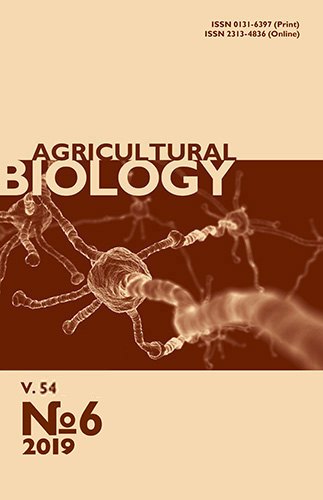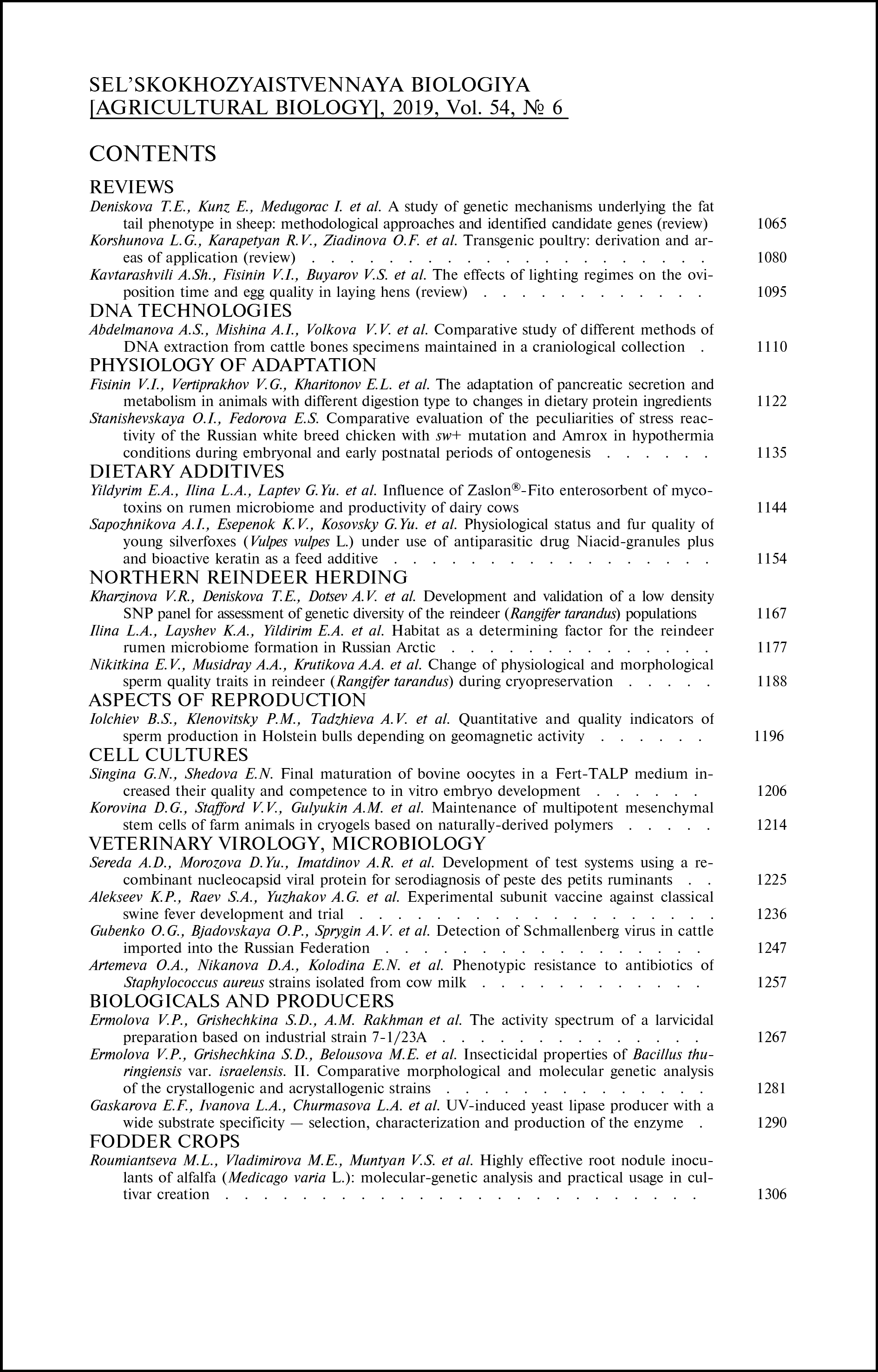doi: 10.15389/agrobiology.2019.6.1214eng
UDC: 619+616.5]:57.085.23
Acknowledgements:
This work was performed as part of research work No. 0578-2018-0006 “Creation of new cell systems with desired properties based on mammalian stem cells, including farm animals for veterinary medicine, virology and biotechnology”.
MAINTENANCE OF MULTIPOTENT MESENCHYMAL STEM CELLS OF FARM ANIMALS IN CRYOGELS BASED ON NATURALLY-DERIVED POLYMERS
D.G. Korovina1, V.V. Stafford1, A.M. Gulyukin1, I.A. Rodionov2,
K.V. Kulakova2, V.I. Lozinsky2, I.P. Savchenkova1
1Federal Science Center Kovalenko All-Russian Research Institute of Experimental Veterinary RAS, 24/1, Ryazanskii pr., Moscow, 109428 Russia, e-mail darya.korovina@gmail.com (✉ corresponding author), staffvicky@mail.ru, plych@mail.ru, s-ip@mail.ru;
2Nesmeyanov Institute of Organoelement Compounds RAS, 28, ul. Vavilova, Moscow, 119334 Russia, e-mail ilyarodionov2@gmail.com, valkirkul@mail.ru, loz@ineos.ac.ru
ORCID:
Korovina D.G. orcid.org/0000-0003-2186-6084
Kulakova K.V. orcid.org/0000-0003-3090-2999
Stafford V.V. orcid.org/0000-0001-8725-2320
Lozinsky V.I. orcid.org/0000-0002-8111-1161
Gulyukin A.M. orcid.org/0000-0003-2160-4770
Savchenkova I.P. orcid.org/0000-0003-3560-5045
Rodionov I.A. orcid.org/0000-0001-8821-2152
Received August 2, 2019
Multipotent mesenchymal stem cells (MMSCs) of farm animals, whose growth in culture is determined by attachment to a solid substrate, are promising cellular material for veterinary medicine and biotechnology, as well as virology. One of the methods to overcome cell adhesion in suspension bioreactors in order to obtain a large number of cells with permanent properties of acceptable quality is the use of porous carriers formed from polymers of natural origin. Thus, for the first time we obtained data that allow us to make a scientific substantiation of the parameters for the cultivation of adhesive cultures of animal MMSCs using spatial protein-based cryogel carriers for subsequent suspension cultivation of the obtained constructs. The purpose of the work is to study the possibility to culture MMSC of farm animals in three-dimensional matrix sponges, i.e. the cryogels based on gelatin, blood plasma total protein and fetal bovine serum (FBS). MMSCs isolated from bovine bone marrow (BM) and adipose tissue (АТ) and ovine BM, as well as mouse fibroblast STO cell line were used. We found that the optimal cell concentration for the settlement of the cell suspension by the method of natural absorption with swelling of squeezed sponges (0.24 cm3 in volume) is 1.0×106 cells per 100 µl of medium for 2 hrs of saturation. The loading efficiency of MMSCs in sponge scaffolds is 98 %. The analysis of histological slices (at least 10 per sample) of three cryogels demonstrated the ability of all three-dimensional porous scaffolds to maintain cell culture for 14 days. Sponges were filled with cells that preserved morphology and proliferated in places of attachment to the polymer surface. The results of experiments on the effect of the matrix material on cell migration showed that all cells migrate from the monolayer in the volume of cryogel from the bottom and are not detected on the upper sides of the cryogels under study. On day 10 of culture, fibroblast STO cell line were detected in the volume of sponge scaffolds based on gelatin, blood plasma and FBS protein at a distance of 2990, 2871 and 1930 μm, respectively. MMSCs isolated from bovine AT migrated into the porous structure of matrix sponges to a depth of 607, 1364 and 657 μm, respectively. Expansion of MMSCs isolated from bovine and ovine BM in cryogels on the basis of different materials did not differ significantly from the migration of AT-MMSCs. The ability of farm animals’ MMSCs on the early passages (2 to 3) and late passages (9 to 10) to attach to macroporous cryogels was not significantly different. Comparative analysis of the results of the experiments obtained in three replicates showed that the macroporous matrices based on gelatin, bovine blood plasma proteins and FBS support the viability of MMSCs during short-term culture, promote cellular adhesion, proliferation and migration. The obtained data allow us to predict the use of these cryogels as matrices for MMSCs of farm animals for research and practical use.
Keywords: multipotent mesenchymal stem cells, adipose tissue, bone marrow, farm animals, adhesion, migration, viability, cryogels, gelatin, bovine protein of blood plasma and serum-derived scaffolds.
REFERENCES
- Savchenkova I.P., Gulyukin M.I. Veterinariya, 2011, 7: 3-5 (in Russ.).
- Rogovaya O.C., Krasnov M.S., Kosovskaya E.V., Kosovskii G.Yu. Mesenchymal stem cells (MSC) as agents, reducing immunogenicity of the graft(review). Sel’skokhozyaistvennaya Biologiya, 2011, 2: 15-20 (in Russ.).
- Panchalingam K.M., Jung S., Rosenberg L., Behie L.A. Bioprocessing strategies for the large-scale production of human mesenchymal stem cells: a review. Stem Cell Res. Ther., 2015, 6: 225 CrossRef
- Tavassoli H., Alhosseini S.N., Tay A., Chan P.P.Y., Weng Oh S.K., Warkiani M.E. Large-scale production of stem cells utilizing microcarriers: A biomaterials engineering perspective from academic research to commercialized products. Biomaterials, 2018, 181: 333-346 CrossRef
- Grein T.A., Leber J., Blumenstock M., Petry F., Weidner T., Salzig D., Czermak P. Multiphase mixing characteristics in a microcarrier-based stirred tank bioreactor suitable for human mesenchymal stem cell expansion. Process Biochemistry,2016, 51(9): 1109-1119 CrossRef
- Moloudi R., Oh S., Yang C., Teo K.L., Lam A.T-L., Warkiani M.E., Naing M.W. Inertial-based filtration method for removal of microcarriers from mesenchymal stem cell suspensions. Scientific Reports, 2018, 8: 12481 CrossRef
- Rafiq Q.A., Ruck S., Hanga M.P., Heathman T.R.J., Coopman K., Nienow A.W., Williams D.J., Hewitt C.J. Qualitative and quantitative demonstration of bead-to-bead transfer with bone marrow-derived human mesenchymal stem cells on microcarriers: utilising the phenomenon to improve culture performance. Biochemical Engineering Journal, 2018, 135: 11-21 CrossRef
- Nienow A.W., Hewitt C.J., Heathman T.R.J., Glyn V.A.M., Fonte G.N., Hanga M.P., Coopman K., Rafiq Q.A. Agitation conditions for the culture and detachment of hMSCs from microcarriers in multiple bioreactor platforms. Biochemical Engineering Journal, 2016, 108: 24-29 CrossRef
- Li B., Wang X., Wang Y., Gou W., Yuan X., Peng J., Guo Q., Lu S. Past, present, and future of microcarrier-based tissue engineering. Journal of Orthopaedic Translation,2015, 3(2): 51-57 CrossRef
- Volkova I.M., Korovina D.G. Three-dimensional matrixes of natural and synthesic origin for cell biotechnology. Applied Biochemistry and Microbiology, 2015, 51(9): 841-856 CrossRef
- Lozinskii V.I. Uspekhi khimii, 2002, 71(6): 559-585 CrossRef (in Russ.).
- Lozinsky V.I. Polymeric cryogels as a new family of macroporous and supermacroporous materials for biotechnological purposes. Russ. Chem. Bull., 2008, 57(5): 1015-1032 CrossRef
- Tikhvinskaya O.A., Rogul'skaya E.Yu., Volkova N.A., Grishchuk V.P., Revenko E.B., Mazur S.P., Lozinskii V.I., Petrenko Yu.A., Petrenko A.Yu. Problemi krіobіologіїі krіomeditsini, 2018, 28(1): 044-048 CrossRef (in Russ.).
- Geckil H., Xu F., Zhang X., Moon S., Demirci U. Engineering hydrogels as extracellular matrix mimics. Nanomedicine, 2010, 5(3): 469-484 CrossRef
- Katsen-Globa F., Meiser I., Petrenko Y.A., Ivanov R.V., Lozinsky V.I., Zimmermann H., Petrenko A.Y. Towards ready-to-use 3-D scaffolds for regenerative medicine: adhesion-based cryopreservation of human mesenchymal stem cells attached and spread within alginate–gelatin cryogel scaffolds. J. Mater. Sci.: Mater. Med., 2014, 25(3): 857-871 CrossRef
- Afewerki S., Sheikhi A., Kannan S., Ahadian S., Khademhosseini A. Gelatin-polysaccharide composite scaffolds for 3D cell culture and tissue engineering: towards natural therapeutics. Bioengineering & Translational Medicine, 2019, 4(1): 96-115 CrossRef
- Ghaderi Gandomani M., Sahebghadam Lotfi A., Kordi Tamandani D., Arjmand S., Alizadeh S. The enhancement of differentiating adipose derived mesenchymal stem cells toward hepatocyte like cells using gelatin cryogel scaffold. Biochemical and Biophysical Research Communications, 2017, 491(4): 1000-1006 CrossRef
- Ferrero-Gutierrez A., Menendez-Menendez Y., Alvarez-Viejo M., Meana A., Otero J. New serum-derived albumin scaffold seeded with adipose-derived stem cells and olfactory ensheathing cells used to treat spinal cord injured rats. Histol. Histopathol., 2013, 28(1): 89-100 CrossRef
- Gallego L., Junquera L., Meana A., Alvarez-Viejo M., Fresno M. Ectopic bone formation from mandibular osteoblasts cultured in a novel human serum-derived albumin scaffold. Journal of Biomaterials Applications, 2010, 25(4): 367-381 CrossRef
- Peña G.I., Álvarez-Viejo M., Alonso-Montes C., Menéndez-Menéndez Y., Gutiérrez Á.F., de Vicente Rodríguez J.C., Otero Hernández J., Meana Infiestae Á. Regeneration of mandibular defects using adipose tissue mesenchymal stromal cells in combination with human serum-derived scaffolds. Journal of Cranio-Maxillofacial Surgery, 2016, 44(9): 1356-1365 CrossRef
- Gallego L., Junquera L., García E., García V., Álvarez-Viejo M., Costilla S., Fresno M.F., Meana Á. Repair of rat mandibular bone defects by alveolar osteoblasts in a novel plasma-derived albumin scaffold. Tissue Engineering Part A, 2010, 16(4): 1179-1187 CrossRef
- Elowsson L., Kirsebom H., Carmignac V., Mattiasson B., Durbeej M. Evaluation of macroporous blood and plasma scaffolds for skeletal muscle tissue engineering. Biomaterials Science, 2013, 4: 402-410 CrossRef
- Tibbitt M.W., Anseth K.S. Hydrogels as extracellular matrix mimics for 3D cell culture. Biotechnol. Bioeng., 2009, 103(4): 655-663 CrossRef
- Volkova I.M., Viktorova E.V., Savchenkova I.P., Gulyukin M.I. Characteristic of mesenchymal stem cells, isolated from bone marrow and fatty tissue of cattle. Sel’skokhozyaistvennaya Biologiya [Agricultural Biology], 2012, 2: 32-38 CrossRef
- Korovina D.G., Volkova I.M., Vasil'eva S.A., Gulyukin M.I., Savchenkova I.P. Tsitologiya, 2019, 61(1): 35-44 CrossRef (in Russ.).
- Lozinsky V.I., Kulakova V.K., Ivanov R.V., Petrenko A.Y., Rogulska O.Y., Petrenko Y.A. Cryostructuring of polymer systems. 47. Preparation of wide porous gelatin-based cryostructurates in sterilizing organic media and assessment of the suitability of thus formed matrices as spongy scaffolds for 3D cell culturing. e-Polymers, 2018, 18(2): 175-186 CrossRef
- Lozinskii V.I., Konstantinova N.R., Solov'eva N.I. Sposob polucheniya poristogo belkovogo gelya. MPK A23J 3/00. Institut pishchevykh veshchestv RAN (RF). № 2058083. Zayavl. 24.02.1994. Opubl. 20.04.1996. Byul. № 11 [A method of obtaining a porous protein gel. MPK A23J 3/00. Institut pishchevykh veshchestv RAN (RF). № 2058083. Appl. 24.02.1994. Publ. 20.04.1996. Bul. № 11] (in Russ.).
- Rodionov I.A. Kriogeli na osnove syvorotochnogo al'bumina: sintez, svoistva, struktura i vozmozhnosti biomeditsinskogo primeneniya. Kandidatskaya dissertatsiya [Serum albumin-based cryogels: synthesis, properties, structure and biomedical use. PhD Thesis]. Moscow, 2017 (in Russ.).
- Pirs E. Gistokhimiya: Teoreticheskaya i prikladnaya [Theoretical and applied histochemistry]. Moscow, 1962 (in Russ.).
- Petrenko Yu.A., Ivanov R.V., Lozinskii V.I., Petrenko A.Yu. Kletochnye tekhnologii v biologii i meditsine, 2010, 4: 225-228 (in Russ.).
- Savchenkova I.P., Savchenkova E.A., Gulyukin M.I. Tsitologiya, 2017, 59(5): 307-314 CrossRef (in Russ.).
- Allan I.U., Tolhurst B.A., Shevchenko R.V., Dainiak M.B., Illsley M., Ivanov A., Jungvid H., Galaev I.Y., James S.L., Mikhalovsky S.V., James S.E. An in vitro evaluation of fibrinogen and gelatin containing cryogels as dermal regeneration scaffolds. Biomaterials Science, 2016, 4(6): 1007-1014 CrossRef
- Chen C.H., Kuo C.Y., Wang Y.J., Chen J.P. Dual function of glucosamine in gelatin/hyaluronic acid cryogel to modulate scaffold mechanical properties and to maintain chondrogenic phenotype for cartilage tissue engineering. Int. J. Mol. Sci., 2016, 17(11): 1957 CrossRef
- Wahl E.A., Fierro F.A., Peavy T.R., Hopfner U., Dye J.F., Machens H.G., Egaña J.T., Schenck T.L. In vitro evaluation of scaffolds for the delivery of mesenchymal stem cells to wounds. BioMed Research International, 2015, 2015: 108571 CrossRef
- Kang B.J., Kim Y., Lee S.H., Kim W.H., Woo H.M., Kweon O.K. Collagen I gel promotes homogenous osteogenic differentiation of adipose tissue-derived mesenchymal stem cells in serum-derived albumin scaffold. Journal of Biomaterials Science, Polymer Edition, 2013, 24(10): 1233-1243 CrossRef












